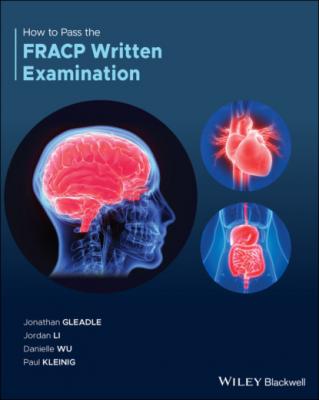How to Pass the FRACP Written Examination. Jonathan Gleadle
Читать онлайн.| Название | How to Pass the FRACP Written Examination |
|---|---|
| Автор произведения | Jonathan Gleadle |
| Жанр | Медицина |
| Серия | |
| Издательство | Медицина |
| Год выпуска | 0 |
| isbn | 9781119599548 |
ECG C has ST changes associated ‘Tented’ T wave in a patient with hyperkalaemia. Significant variations of potassium levels have dramatic effects on electrical activities and cause arrhythmias. Hyperkalaemia induces an ST elevation in right precordial leads that can resemble an AMI. Other ECG changes in hyperkalaemia include reduction in the amplitude of P waves, prolongation of the PQ interval, enlargement of QRS complex and concave ST segment elevation.
ECG D shows widespread concave (‘saddleback’) ST segment elevation in a patient with pericarditis. Although pericardium is electrically inactive, its infection and/or inflammation as seen in this case of uraemic pericarditis may affect the external part of epicardium and cause concave ST elevation in almost all leads, as pericarditis generally affects the whole pericardium.
Smith S, Dodd K, Henry T, Dvorak D, Pearce L. Diagnosis of ST‐Elevation Myocardial Infarction in the Presence of Left Bundle Branch Block With the ST‐Elevation to S‐Wave Ratio in a Modified Sgarbossa Rule. Annals of Emergency Medicine. 2012;60(6):766–776. https://www.annemergmed.com/article/S0196‐0644(12)01368‐6/fulltext
7. Answer: D
Extracorporeal membrane oxygenation (ECMO) is an advanced form of temporary life support which helps to maintain respiratory and/or cardiac function. It diverts venous blood through an extracorporeal circuit and returns it to the body after gas exchange through a semi‐permeable membrane. ECMO can be used for oxygenation, carbon dioxide removal and haemodynamic support. Additional components allow thermoregulation and haemofiltration. The two most common forms of ECMO are: (i) veno‐arterial ECMO (VA‐ECMO) to support patients with a reversible cause of cardiogenic shock that is refractory to maximal therapy. VA‐ECMO can also be a salvage treatment option in the setting of cardiac arrest with unsuccessful advanced life support. (ii) veno‐venous ECMO (VV‐ECMO) is indicated for patients with a reversible cause of acute respiratory failure with refractory hypoxaemia or hypercapnia despite optimal ventilation. VV‐ECMO allows reduction in the ventilatory insult caused by mechanical ventilation.
The indications and contraindications for ECMO in critically ill patients are listed in Tables 2.1 and 2.2.
Table 2.1 Indications for ECMO.
| Indications for VA‐ECMO | Indications for VV‐ECMO |
|---|---|
| Acute myocardial infarction | Reversible causes of acute respiratory failure |
| Fulminant myocarditis | ARDS |
| Acute exacerbations of chronic CCF | Trauma—extensive pulmonary contusion |
| Cardiac failure due to intractable arrhythmias | Massive pulmonary embolism with refractory shock and/or cardiac arrest |
| Primary graft failure following cardiac transplantation | Graft dysfunction following lung transplantation |
| Acute heart failure secondary to drug toxicity | Inability to provide adequate gas exchange without risk of ventilatory injury |
| Postcardiac arrest (as part of advanced life support) | Pulmonary haemorrhage |
Table 2.2 Contraindications to ECMO.
| Chronic respiratory or cardiac disease with no hope of recovery or transplant |
| Out‐of‐hospital cardiac arrest with prolonged down time |
| Severe aortic regurgitation or type A aortic dissection or severe peripheral vascular disease if using VA‐ECMO |
| Refractory septic shock in adults with preserved left ventricular function |
| ARDS with advanced multiorgan failure |
| ARDS in patient with advanced age |
| Prolonged pre‐ECMO mechanical ventilation |
| Therapeutic anticoagulation is a relative contraindication |
Ali J, Vuylsteke A. Extracorporeal membrane oxygenation: indications, technique and contemporary outcomes. Heart 2019; 105:1437–43.
https://heart.bmj.com/content/105/18/1437.abstract
8. Answer: A
The most common cause of drowsiness in the admitted patient is a metabolic encephalopathy. Thorough neurological examination is needed, however, to rule out focal central nervous system pathology. Common causes of encephalopathy are infection, medications, decompensated hepatic failure, and hypercania. Less common causes include endocrine causes and electrolyte disturbance. In this case, type 2 respiratory failure is the most likely cause given the findings on history and examination.
Alpert J. Evaluation of the Poorly Responsive Patient. The Neurologic Diagnosis [Internet]. 2018 [cited 30 June 2020];163–206. Available from: https://link.springer.com/chapter/10.1007/978‐3‐319‐95951‐1_5
9. Answer: C
Intra‐aortic balloon pump (IABP) is a percutaneous temporary mechanical circulatory support that creates more favourable balance of myocardial oxygen supply and demand by using systolic unloading and diastolic augmentation.
The IABP, by inflating during diastole, displaces blood volume from the thoracic aorta. In systole, as the balloon rapidly deflates, this creates a vacuum effect, reducing afterload for myocardial ejection and improving forward flow from the left ventricle. The net effect is to decrease systolic aortic pressure by as much as 20% and increase diastolic pressure, but the MAP is usually unchanged. This subsequently results in decreased left ventricle wall stress reducing the myocardial oxygen demand. Overall, these haemodynamic changes indirectly improve the cardiac output by increasing stroke volume, particularly in patients with reduced left ventricular function. The augmentation of diastolic pressure by IABP leads to an increase in myocardial perfusion especially epicardial coronary circulation.
Indication for placement can include:
Myocardial infarction with decreased left ventricular function leading to cardiogenic shock
Myocardial
